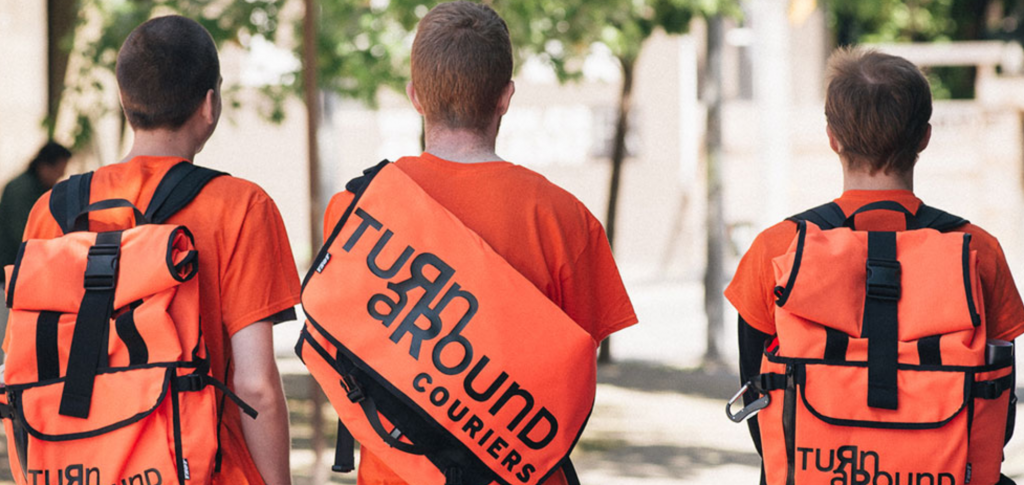Founded in October 2002, TurnAround Couriers (TAC) is a for-profit, same-day courier business. What makes it unique is that it is focused on providing steady jobs and support for continuing education for at-risk youth in Toronto, Ontario, Canada.
Since inception, TAC has employed over 170 young people in all roles throughout the company. They have partnered with local youth agencies and shelters to help with the initial screening and vetting process for potential new hires. All staff are supported with training, and innovative workplace practices such as cash advances to help cover initial courier costs like a bicycle or helmet, and these costs are deducted over time off future pay checks in small increments.
[button_1 text=”Visit%20Turn%20Around%20Couriers%20Website” text_size=”23″ text_color=”#ffffff” text_font=”Gill Sans;default” text_letter_spacing=”0″ subtext_panel=”N” text_shadow_panel=”N” styling_width=”25″ styling_height=”8″ styling_border_color=”#000000″ styling_border_size=”0″ styling_border_radius=”6″ styling_border_opacity=”100″ styling_gradient_start_color=”#ED8D00″ styling_gradient_end_color=”#F56F0E” drop_shadow_panel=”N” inset_shadow_panel=”N” align=”center” href=”http://www.turnaroundcouriers.com/” new_window=”Y”/]
[divider style=”9″]
Turn Around Couriers Case Study
Published April 22, 2015
Key Takeaways:
[bullet_block large_icon=”24.png” width=” font_size=”18″]
- Providing a courier service that competes with traditional for-profit courier companies means that TAC needs to keep prices competitive and offer quality service.
- At times there are challenges achieving profitability, but with clear systems in place to measure both financial results and achievement of social impact goals, both money and mission are kept in balance.
- TAC’s competitive advantage is it’s ability to offer the same price and quality of service as traditional couriers, while leveraging their mission activities as a differentiator.
- Having a social mission is not enough to provide a sustainable competitive advantage over time. You need to also deliver on factors like price and service quality. Richard says, “I think that you have to have a proper, standard business case first before you can start adding all the bells and whistles in the form of social hiring”
- The profit-centre of a social enterprise needs to be built with the beneficiaries in mind. Founder, Richard, emphasizes that the service “had to be something that the targeted population could do. The youth at risk I’ve been working with can bicycle courier while they might not be able to work in other ventures one might choose to start. So it’s important to tailor the nature of your operation to the community you are trying to help, obviously”.
- A social enterprise cannot achieve it’s impact goals if the business model is not sound first and foremost, because without sustainable revenue the impact cannot be funded and realized.
- Starting out, TAC experienced only 10% of verbal commitments following through into firm contracts. Ensure forecasts are realistic, and ideally have firm commitments, before launching.
- Fostering a strong network was key in gaining reputation, connecting with potential customers, and securing new customers.
- Building in opportunities, incentives, and removing barriers for employees to engage in training and education deepened TAC’s social impact.
[/bullet_block]
[button_1 text=”Read%20Full%20Case%20Study%20Here” text_size=”23″ text_color=”#ffffff” text_font=”Gill Sans;default” text_letter_spacing=”0″ subtext_panel=”N” text_shadow_panel=”N” styling_width=”25″ styling_height=”8″ styling_border_color=”#000000″ styling_border_size=”0″ styling_border_radius=”6″ styling_border_opacity=”100″ styling_gradient_start_color=”#ED8D00″ styling_gradient_end_color=”#F56F0E” drop_shadow_panel=”N” inset_shadow_panel=”N” align=”center” href=”https://tricofoundation.app.box.com/TACsocialenterprisecasestudy” new_window=”Y”/]
